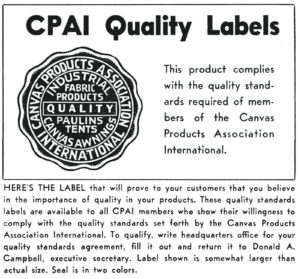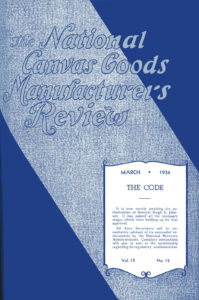
Attempts to maintain fair competition, both national and international, have become far more complex in a global marketplace.
George Washington, looking at Betsy Ross’ first attempt at sewing a national flag: “You having a little fun at your country’s expense?”
Betsy Ross: “How’s that?”
GW: “Are you kidding with these colors here? Red? White? And blue?!!”
BR: “Well, those are the only remnants I had around th…”
GW: “Wait a minute! Stars?! I deliberately said polka dots!”
(From ”Stan Freberg Presents the United States of America Volume One: The Early Years,” 1961.)
From the time of the American Revolution, suppliers to the government have had issues with meeting expectations and in turn have found fault with regulations and national and international trade issues. For the newly formed National Tent and Awning Manufacturers Association this issue played a role from the beginning, as many member firms had longstanding agreements to supply canvas goods to some branch of the national armed forces or local militia. In addition to providing a steady income, the links with military purchasing filled in work during slow off-season periods.
Increasing complaints about inferior goods coming from the competition led the Review editor to speak out in the Jan. 1925 issue: “The Review could take on a lot more advertising but will not do so because advertising more or less covers inferior grades of material,” said McGregor. “After many years of hard work—the National Association of Tent & Awning Manufacturers had gradually developed the thought amongst members that ‘Quality Goods’ is one definite way of evaluating the spirit of goodwill amongst consumers of their goods … It is up to us to take such action against shysters who are besmirching the good name of this Association by underselling our manufacturers on misrepresentation of stock.”
The challenge of overcoming inferior work by awning manufacturers who were not members, and who reportedly produced low quality at lower prices, prompted members of the association to call for a code of ethics and best practices to ensure quality throughout the industry.
Early influences
As early as the 1930s, issues of concern extended beyond the nation’s borders to worldwide relations and market competition. In an Aug. 1931 article about the influx of lower cost cotton, the headline reads: “Relation of Soviet Russia to the World Cotton Market” with the subhead “Russian Cotton Threat to South” reportedly because of price cuts and exporting to Britain. At the time, according to the article, the Soviet Union was the fourth largest producer of cotton in the world.
Shortly after that, the world fell into the Great Depression, and talk turned to sustaining business by any means. The Review accordingly turned to encouraging articles and editorials on leadership and positive attitudes, and promoted business and technical innovations that could help improve a company’s bottom line.
Concern also focused on political leadership at the national level and targeted a growing concern about graft versus justice. Under the headline “A New Era,” the March 1933 Review editorial argued that “Congress is now completely irresponsible” and claimed “America today is tyrannized by 500,000 of the worst type of political parasites that ever occupied the seat of power, and it is just a question of how long the country can stand it, and how long the spirit of patience can be exercised by its citizenship.”
The Association approved a “Code of Fair Competition” for the canvas goods industry on March 16, 1934. Another national issue soon presented itself, under the title of “United States Army Specifications KT-211” reported in the April 1935 issue. This specification attempted to define materials for use in military goods manufactured for use by the U.S. Army. Apparently these specs were not acceptable to the Association and its members, prompting an open letter published in the January 1937 issue: a “Petition to the Procurement Chief of the United States” regarding bidding for government work.

“For the last few years a great deal of agitation and bad feeling has been created amongst manufacturers in the canvas goods manufacturing industry because of the ‘unprofitless prices’ which have been incident to the U.S. Government bidding and this has been true in connection with requested bids for the WPA.”
Industry issues included the amount of taxes the government applied to all goods sold, and setting prices so low that manufacturers could barely break even. “Due consideration should be given by government to ‘What It Costs Our Men to Do Business’ and not to disrupt channels of commerce by setting prices which are not ridiculously low and out of proportion to commercial transactions.”
As the U.S. slowly moved to engage in WWII, this contentiousness was resolved, and manufacturers willingly worked to support all efforts to supply the armed forces with needed goods.
The establishment of the “War Production Board” in 1943 centralized demand and purchasing of canvas covers for army tanks, trucks and artillery, as well as tents and other supplies used in troop transport. It was a direct response to the governments Controlled Materials Plan M-126 restricting the use of many materials (normally used in the commercial canvas products industry) to primarily military use.
National and international
After the war, emphasis shifted to reconstructing the economy and rebuilding commercial markets, as well as re-employing returning soldiers (and laying off many women hired during wartime). Industry issues with government control and product specifications were subsumed by growth in new products and new markets and the introduction of new materials offering greater performance and durability (see “Advances in technology”). Still, a June 1961 Review column urged manufacturing businesses to work more closely with local code officials; building codes remained a perennial stumbling block to getting fabrics approved for use in local construction. (And that is still an issue today, as organizations such as the Fabric Structures Association, a division of IFAI, work to update and standardize building codes.)
Despite all the technological changes in a global marketplace, the issue of a skilled workforce—and the wages they’ll require—remains critical.
International trade, especially importing of fabrics from overseas into the U.S., became much more of an issue in the 1970s. The benefits of thinking globally and acting locally were touted, emphasizing the creation of stronger links among all parts of the supply chain throughout the entire specialty fabrics industry. But the production of fabrics and apparel in the U.S. also began to suffer in the latter part of the 20th century; much cheaper (and often much more cheaply made) imported fabric had U.S. manufacturers worried about price and quality, and much of the apparel industry moved offshore as well, attracted by cheap labor, especially in Asia. Over the last 15 years or so, however, the trend to high-performance technical fabrics and products that could not be manufactured overseas helped the U.S. industry bounce back. Even the apparel industry is seeing a national resurgence as consumer preferences and demands become more sophisticated. Exporting these products to other countries is beginning to balance the trade equation, but a proliferation of trade agreements means a shifting economic landscape continues.
The Information Age is typically defined to have started in the early 1970s and extended to the early 1990s. Coincident to that game-changer is a rapid worldwide growth that Joe Belli, president of Eide Industries in Cerritos, Calif., points out included widespread automation and computerization of the industry. He further identifies the big changes in the specialty fabrics industry as “the increasingly global economic environment and rapid growth of international import and export patterns. It was impossible to ignore these changes without the risk of being left out of the market.”
Despite all the technological changes in a global marketplace, the issue of a skilled workforce—and the wages they’ll require—remains critical. “As manufacturers in the U.S., we must recognize that the lower wages paid in third-world countries are driving down manufacturing costs and selling prices,“ Belli says. “U.S. manufacturers need to recognize and react appropriately to this global change in the workforce, or they will not remain competitive, in the U.S. or abroad. To remain competitive, we must automate, become more efficient and develop other ways to cut both operations and manufacturing costs.”
 TEXTILES.ORG
TEXTILES.ORG


